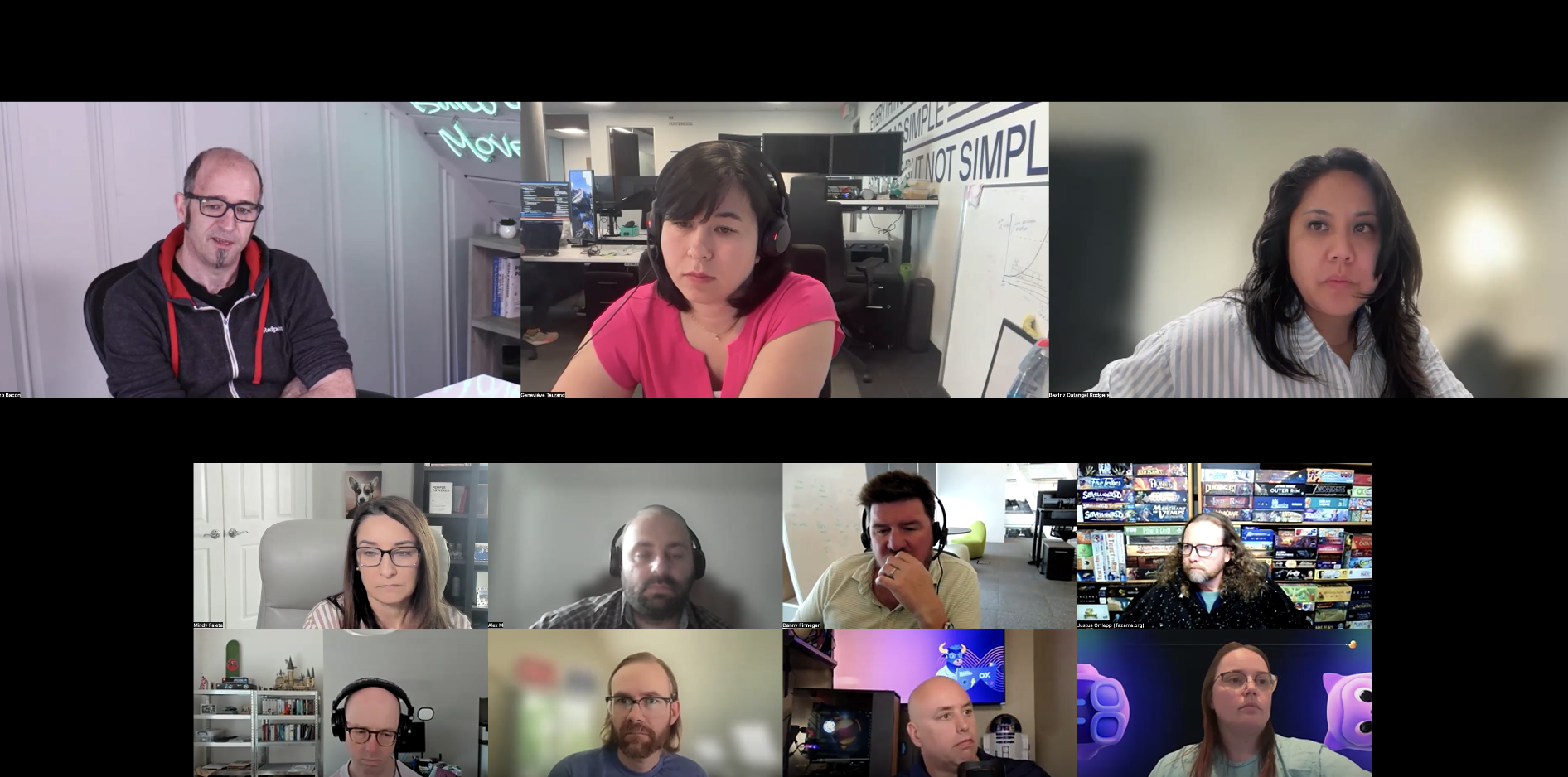Most people approach their conference CFP strategy the wrong way. They treat proposals like academic essays: long, abstract, and generic. And then they’re surprised when program committees pass.
The truth? When committees review CFPs, they scan your title, glance at your bio, and make a near-instant decision about whether to keep reading. A strong conference CFP strategy isn’t about sounding smart — it’s about signaling clarity, credibility, and practical value fast.
After reviewing hundreds of proposals and serving on multiple program committees, we’ve seen exactly what gets accepted and what gets ignored. The difference isn’t polish. It’s precision.
If you want a conference CFP strategy that consistently gets you accepted — and positions you as someone bringing real insight to the room — this playbook gives you the exact blueprint.
Conference CFP Strategy: What We Covered in the Deep Dive Session
Earlier this week, we ran a Stateshift deep dive session focused entirely on conference CFP strategy — how to craft proposals, how to deliver talks, and how to stand out in increasingly competitive submission pools.
We didn’t just talk theory.
We reviewed real CFPs — some accepted, some rejected — and workshopped titles, abstracts, and bios live. Members reshaped their proposals in real time and saw immediate clarity gains.
Member insights:
“I learned that writing the title first, not last, completely changes the abstract quality. It forces clarity early.”
“I thought my abstract was strong until we broke it down live. It lacked clear takeaways and felt more like an essay than a pitch.”
During the session, Jono shared what committees rarely admit publicly:
“We say we read every word, but in reality, we make quick judgments from the title and bio. You have seconds to hook us.”

The C’s Framework: Your Secret Weapon for a Standout Conference CFP Strategy
Inside the session, Jono introduced two simple frameworks that dramatically improve the quality of your CFPs.
The Three C’s for Titles
- Curiosity — give reviewers a reason to lean forward
- Conjure Imagination — help them picture the session
- Concise — short enough to remember, share, and approve quickly
Titles built with this framework outperform descriptive ones because they spark interest without overwhelming the reviewer.
The Four C’s for Abstracts
- Contrarian — start with a surprising or challenging statement
- Clarify — explicitly state what the talk covers
- Credibility — show why you’re the right person to teach it
- Capabilities — list the outcomes attendees will leave with
When your conference CFP strategy uses this framework, your proposal transforms from generic to high-value instantly.

During our session, members realized that using these frameworks forced them to focus on delivering value, not just filling space. Moving from broad overviews to clear, specific outcomes changed the entire pitch.
Real CFP Reviews: What Worked and What Didn’t
In our live review, members shared draft titles and abstracts. We examined each closely, discussed strengths and weaknesses, and refined them to be sharper and more outcome-focused.
Some submissions started strong but drifted into general or overly broad territory. Together, we worked to highlight advanced techniques and real lessons learned — shifting from surface-level overviews to authoritative, high-value sessions.
What stood out:
- Short, compelling titles stand out far more than long, descriptive ones.
- Abstracts need to show clear attendee outcomes rather than simply “raise awareness.”
- Including specific stories or real data points immediately increases credibility and interest.
These insights became instant upgrades to everyone’s conference CFP strategy.
How to Write a Speaker Bio That Makes Committees Instantly Trust You
Most bios are bloated. Reviewers don’t want your life story — they want a sentence that proves you’re legitimate.
A strong bio:
- States your experience clearly
- Mentions relevant companies, projects, or results
- Shows domain credibility instantly
Your bio is a trust signal. With a good one, reviewers lean in. With a weak one, they stop reading.
Delivering a Talk That Actually Lands
Once your conference CFP strategy gets you accepted, your next job is delivering a session that people remember.
A great talk:
- Tackles a real audience problem
- Shares failures, trade-offs, and lessons learned
- Offers practical techniques people can apply immediately
Attendees don’t want theory. They want insight. They want stories. They want honesty.
This is where many speakers fall short.
Why Stateshift — and Why Your CFPs Matter More Than You Think
At Stateshift, we teach companies how to build ecosystems of users, contributors, and champions. Conference talks are one of the most powerful accelerants — if you use a strong conference CFP strategy.
With 27+ years helping 240+ technical companies grow through content, community, and reputation-building, we’ve seen how conference talks can create long-term momentum when approached strategically.
A great CFP gets you accepted.
A great talk gets you remembered.
A great strategy turns both into inbound energy, trust, and revenue.
Key Takeaways
- Your conference CFP strategy must start with a sharp, curiosity-driven title
- Abstracts work best when contrarian, clear, credible, and outcome-driven
- Bios should prove expertise in one minimalist sentence
- Great talks share real stories, real failures, and real lessons
- You’re competing for seconds of reviewer attention — clarity wins
Ready to Make Your Next Talk Actually Matter?
If you want your talks to drive developer trust, community energy, and actual business outcomes — not just get you on stage — Stateshift can help.
We help leaders craft a conference CFP strategy that gets accepted consistently and turns every talk into long-term engagement and growth.
Frequently Asked Questions
What makes a good conference talk title?
A good title sparks curiosity, is easy to remember, and hints at a clear outcome. Short, punchy titles outperform long or vague ones — think “Why Open Source Projects Stall (and How to Fix It)” vs. “Improving Collaboration in Technical Communities.”
How long should my abstract be?
Aim for 100–150 words. Start with a contrarian hook, clearly define what the talk will cover, briefly mention your credibility, and highlight specific attendee takeaways. Think pitch, not essay.
What should I avoid in a CFP submission?
Avoid jargon, broad claims without substance, and filler phrases like “we’ll explore…” or “this session will cover…” Get to the point, show value, and use real examples where possible.
What do conference committees actually look for?
They skim fast. A compelling title, clear outcomes, and relevant credibility matter most. They want sessions that will teach something useful, not self-promotion or abstract ideas.
How do I make my talk stand out without being clickbait?
Use Stateshift’s “C’s” framework: be bold, but back it up. A strong hook + clear value = trust. Your goal is to invite curiosity, not manipulate it.
What if I don’t have speaking experience yet?
That’s fine — lead with your expertise. Focus your bio on what you’ve built, solved, or led. Even one strong case study or insight can be enough if you frame it well.
How can I improve my chances of getting my talk accepted?
Start with the title. Workshop it with others. Use frameworks like Stateshift’s “C’s,” get feedback, and revise. Don’t wait until the end to fix your abstract — start with clarity.
Watch More
For more tips, check out this video Jono created a few years ago on conference talk best practices:





